As an Amazon Associate, I earn from qualifying purchases.
As an Amazon Associate, I earn from qualifying purchases
If you want your cooking to be efficient and fun, choose the correct cookware material. Think about heat conductivity, longevity, food reactions, maintenance ease, weight, and price. Cast iron, with regular care, retains heat very well; aluminum, despite its low weight, can react with some meals, and copper, with its extraordinary heat conductivity, is the most versatile and long-lasting material. Making an educated choice based on your cooking preferences and demands is crucial for a fulfilling culinary experience since each material has benefits.
Different types of cookware materials:
- Stainless steel
- Aluminum
- Copper
- Cast Iron
- Enameled cast iron
- Carbon Steel
- Nonstick
- Ceramic
- Anodized Aluminum
- Glass
- Titanium
- Enamel
- Granite
- Bamboo
Lets Discuss:
1. Stainless steel:
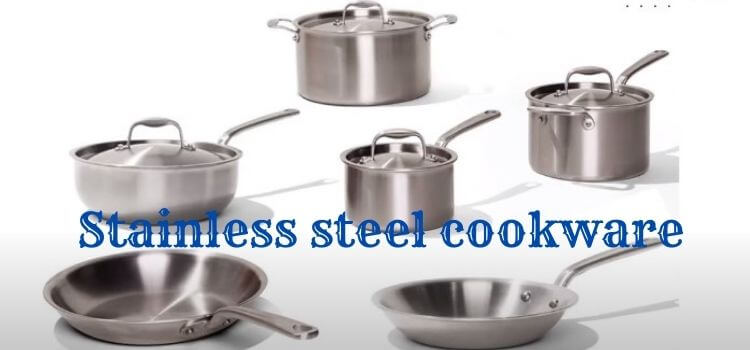
What is stainless steel?
Stainless steel, an alloy of steel, must have at least 10.5% chromium by mass to be considered. Chromium plating on the surface of steel forms an oxide layer that acts as a protective barrier; this layer is called the passive layer. Adding this layer enhances stainless steel’s resistance against corrosion, rust, and stains.
Stainless steel is not just made of chromium; it can also contain nickel, molybdenum, titanium, and copper. The exact amounts of these elements depend on the grade and the use. These supplementary components enhance the material’s strength, longevity, and resistance to corrosion, among other qualities.
Stainless steel is a popular material for many goods and sectors because it is strong, corrosion-resistant, and looks great. Among the many common uses are kitchen appliances, medical utensils, building supplies, automobile components, and many more. Stainless steel’s adaptability makes it a favorite in the manufacturing and consumer goods industries.
What is stainless steel cookware?
Stainless steel is an iron-based corrosion-resistant alloy that must include at least 10.5% chromium; it is used to make a variety of cooking equipment, pots, and pans. Chromium, when added to cookware, creates an oxide coating that prevents rust and corrosion.
Stainless steel cookware has several great qualities, such as being long-lasting, resistant to stains, and not reacting with food. It is resistant to corrosion and tarnish, resistant to warping at high temperatures, and inert when exposed to acids or bases.
Various kitchen tools, baking sheets, pots, and pans made of stainless steel are commonplace. Stainless steel is a common component in high-quality cookware sets because of its longevity and the fact that it requires small amounts of maintenance. There is a lot of praise for cookware made of stainless steel because of its contemporary style, its ability to provide uniform heating, and its capacity to avoid chemical leaching into food.
PROS
CONS
2.Aluminum:
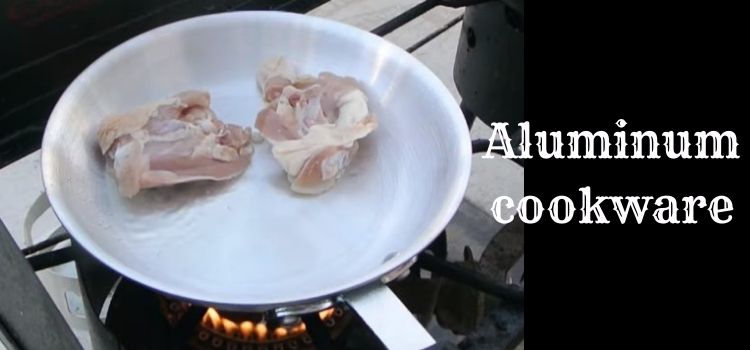
What is aluminium?
With the atomic number thirteen and the symbol Al, aluminum is a chemical element. Its low density and resistance to corrosion make this silvery-white metal ideal for lightweight applications. Many different industries make use of aluminum due to its adaptability and versatility. These include transportation, building, packaging, and aerospace. Its strength and endurance are improved through alloying with other metals. Because of its malleability and resistance to corrosion, aluminum finds widespread application in domestic items such as cookware, foil, and beverage cans.
What is aluminium cookware?
Cooking implements, pans, and other cookware constructed from aluminum are collectively known as aluminum cookware. Because of the metal’s low price, high heat conductivity, and portability, these products find widespread use in kitchens. Aluminum cookware is sometimes anodized or coated with a nonstick material for added longevity and corrosion resistance. Despite its general use, aluminum cookware isn’t without its detractors, who worry about the health risks associated with aluminum seeping into meals. Coatings or anodized aluminum, which forms a protective layer on the surface, are common ways manufacturers solve the issues.
PROS
CONS
3. Copper:
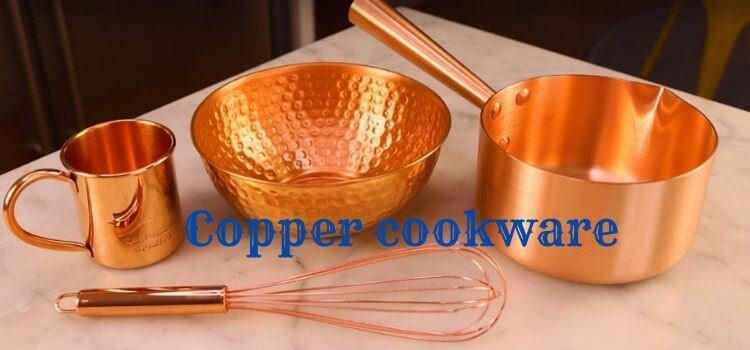
What is copper?
The atomic number of copper is 29, and its symbol is Cu. Its striking reddish-orange colour reflects its ductility, thermal solidity, and electrical conductivity. Copper has been in existence for thousands of years and is a highly valued metal with numerous applications. Plumbing, electrical wiring, and many industrial processes all rely on it. The exceptional heat conductivity of copper makes it a popular material for cookware in the culinary arts, enabling exact temperature regulation. Copper acquires a distinctive patina, a greenish layer, with age; this layer does not affect the metal’s functionality.
What is copper cookware?
Copper cookware includes various cooking implements, including pans, pots, and utensils. Thanks to their high heat conductivity, these cookware products let you regulate the temperature of your food to perfection. Lining copper cookware with another material, such as tin or stainless steel, makes it more durable and stops reactions with some foods. While copper cookware is highly sought after for its performance, it can be pricey compared to other materials. Additionally, it may require upkeep to keep it looking good since copper naturally acquires a patina with time.
copper cookware for induction your review our post.
PROS
CONS
4. Cast iron:
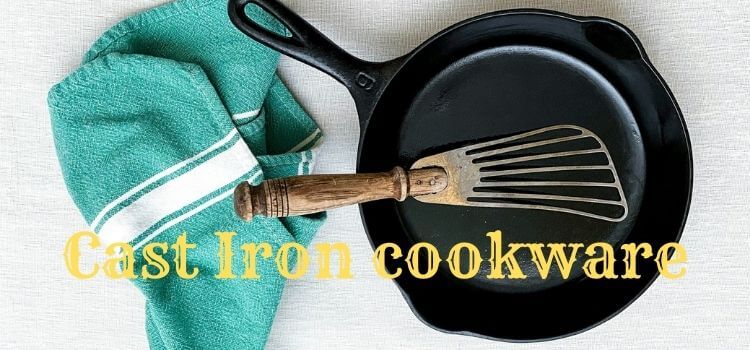
What is cast iron?
Iron, carbon, and silicon are the main components of cast iron, an alloy that is both strong and long-lasting. Its production process involves melting iron and adding a trace quantity of carbon to increase its hardness and strength. Cast iron gets its thick, hefty appearance from pouring molten iron into molds.
Skillets, pots, and Dutch ovens made of cast iron are well-liked by cooks because they retain and distribute heat evenly. It can be used for frying, baking, and slow cooking, among other methods, contributing to its versatility. Seasoning, the gradual accumulation of oils on cast-iron cookware, creates a naturally nonstick surface. Cast iron cookware may be protected from rust and kept in good condition with regular maintenance, including seasoning and cleaning.
What is cast-iron cookware?
A wide range of cookware and serving pieces are produced from cast iron. This category includes works, pans, Dutch ovens, grills, and similar tools. Cookware made of cast iron is long-lasting, heats food evenly, and retains heat exceptionally well. Cookware manufactured from molten iron is thick and heavy and able to endure high temperatures because the metal is poured into molds. With the right amount of seasoning and maintenance, cast iron can produce a naturally nonstick surface, making it even better at cooking. Cast iron is the go-to pan for all your cooking needs, from frying to baking to roasting to slow cooking.
cast iron vs ceramic cookware you can review our post .
PROS
CONS
5. Enameled cast iron:

What is Enameled cast iron Cookware?
Cookware made of cast iron that has been coated with enamel, a transparent, smooth, and long-lasting material, is known as enameled cast iron. Along with protecting the cast iron from rust, this enamel covering makes seasoning unnecessary. Enamel also provides a non-reactive surface, so you may cook acidic items without worrying about releasing metallic tastes.
Thanks to its attractive look, long lifespan, and adaptability, enameled cast-iron cookware—including skillets and Dutch ovens—is much sought after. Enamel coating gives it a range of colors and makes maintenance more accessible, while classic cast iron maintains heat.
PROS
CONS
6. Carbon Steel:

What is carbon steel?
Carbon steel is a type of steel that primarily consists of carbon and iron. It ranks high among the many uses for this material in building and manufacturing. Higher carbon concentrations result in greater hardness and strength; the usual range for carbon content in carbon steel is 0.05–2.0 percent.
Carbon is the defining element of carbon steel, which results in the material’s exceptional toughness, strength, and longevity. Still, it opens the material up to corrosion. It is common practice to galvanize or coat carbon steel with protective materials to increase its resistance to corrosion.
Among carbon steel’s many uses are those in the building trade, the automobile industry, infrastructure, and tools. It is highly favored because of its low price, ease of machining, and welding capabilities. Various carbon steel grades and varieties are available to cater to multiple applications’ demands for strength, hardness, and other qualities.
What is carbon steel cookware?
Any cookware or utensils constructed from carbon steel is known as carbon steel cookware. This cookware’s longevity, heat retention, and adaptability make it a fan favorite. Carbon steel, an iron alloy containing a trace amount of carbon—often between one and two percent—is ideal for use in cookware. The cookware retains a reasonable amount of light despite the composition’s hardness and robustness.
The rapid heating and uniform heat distribution that characterize carbon steel cookware are well-known. For this reason, it is well-liked by both amateur and professional cooks. In addition, with the correct seasoning, the material gains a natural nonstick patina that makes it work better and keeps food from adhering.
Pans, woks, paella pans, and grills made of carbon steel are commonplace in the kitchen. Carbon steel cookware must be seasoned on a regular basis with a thin coating of oil and baking in order to prevent rust and enhance its nonstick properties.
Many people love carbon steel cookware because it lasts a long time, cooks evenly, and may take on its own character with use. However, it does require maintenance to keep it in good working order.
PROS
CONS
7. Nonstick:
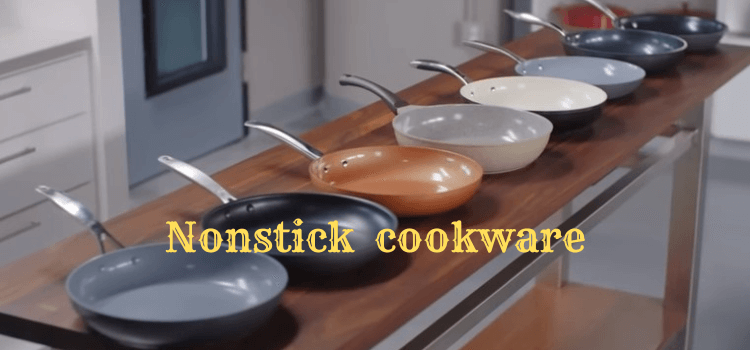
What is Nonstick cookware?
A special coating on certain types of cookware called “nonstick” keeps food from sticking while it’s cooking. Polytetrafluoroethylene (PTFE), the material most often used to make this coating, goes by Teflon. Using nonstick cookware simplifies food release, makes cleanup a breeze, and reduces the need for oil or fat while cooking. Pancakes and eggs, for example, are known to stick easily. Therefore, this is a standard method for cooking them.
PROS
CONS
8. Ceramic:
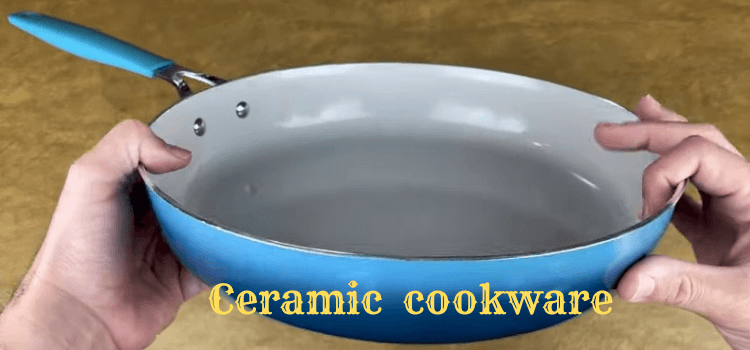
What is ceramic?
Ceramics are a wide variety of materials that have been heat-treated, typically to very high temperatures, to form a solid and long-lasting structure. These materials have many uses due to their increased electrical insulating capabilities, exceptional heat resistance, and other desirable qualities. Various ceramics are available, from the more commonplace pottery and tiles to more complex ceramics utilized in engineering and electronics, among other fields. Ceramic coatings can improve the performance of pans and pots and create a nonstick surface when applied to cookware.
What is Ceramic cookware?
Any implements, pots, and pans with a ceramic coating are called ceramic cookware. Coatings like this improve the performance of cookware by creating a nonstick surface. Its most notable features are the consistent distribution of heat and the smooth, easy-to-clean surface of ceramic cookware.
Ceramic coatings are often crafted from various types of clay and other naturally occurring materials. The chemicals used in conventional nonstick coatings are not present in this product. The non-reactive nature of ceramic cookware makes it a popular choice since it prevents the leaching of dangerous compounds into meals.
A wide variety of ceramic cookware is available, from pans with a ceramic coating to ones made entirely of ceramic. Aesthetics, usability, and compatibility with low to medium-heat cooking techniques contribute to its high value.
A Few Pros and Cons of ceramic cookware:
PROS
CONS
9. Anodized Aluminum:
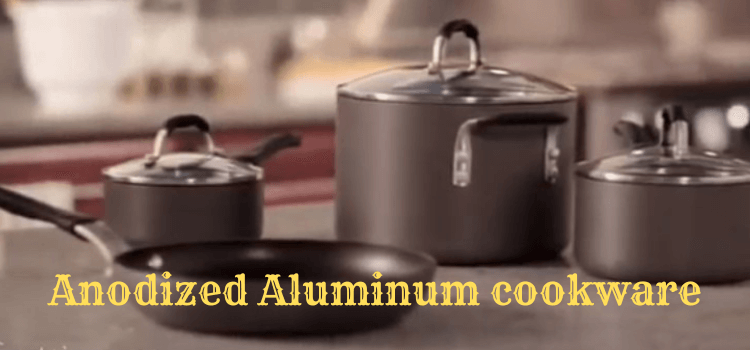
What is Anodized Aluminum cookware?
Anodized aluminum kitchenware is made from aluminum that has been anodized, which is an electrochemical process. This technique makes the aluminum’s natural oxide layer thicker, more difficult to penetrate, and less rust-prone. People love anodized aluminum cookware because it lasts long, heats evenly, and doesn’t scratch or corrode. The surface of the pan is normally non-reactive, allowing it to cook a variety of meals. This material is often used to make pots, pans, and other kitchen tools. The anodized finish makes the surface smoother and more robust than aluminum, which hasn’t been treated.
PROS
CONS
10. Glass:
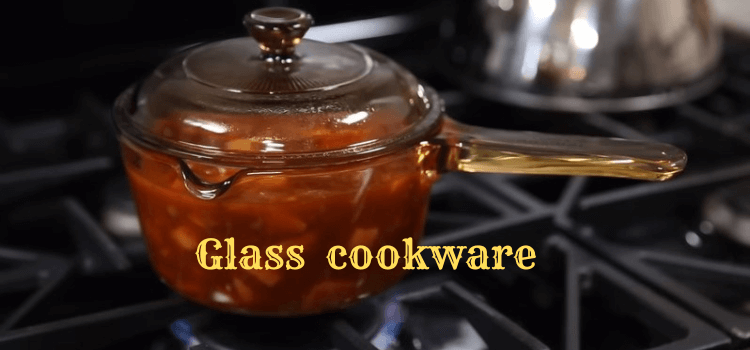
What is Glass?
Glass is a solid, explicit, or see-through material that is usually made by melting silica, soda ash, and limestone and then quickly cooling the liquid mixture to make a solid structure. Because it is smooth and doesn’t contain crystals, it is used for many things, like windows, containers, dishes, and optical lenses. Glass is known for being precise, long-lasting, and helpful in many fields because it can be shaped into different forms. It can also be recycled, which makes it an eco-friendly medium when used correctly.
What is Glass cookware?
Glass cookware includes dishes and cooking tools that are mostly made of Glass. This kind of cookware handles high temperatures and can be used for cooking, like roasting, baking, and cooking in the oven. Pans made of Glass can be used for baking, making casseroles, pies, and so on.
Some of the most essential things about glass cookware are that it is clear, so you can see what’s going on, and it can spread heat evenly. It doesn’t mix with the food being cooked so that the taste of the food will stay the same. People also like glass cookware because it is easy to clean and doesn’t stain or smell.
Although glass kitchenware is practical and can be used for many things, it should be handled carefully so that it doesn’t break or shatter when the temperature changes quickly. Glass cookware from well-known names is often found in kitchens and is used for baking and serving.
PROS
CONS
11. Titanium:
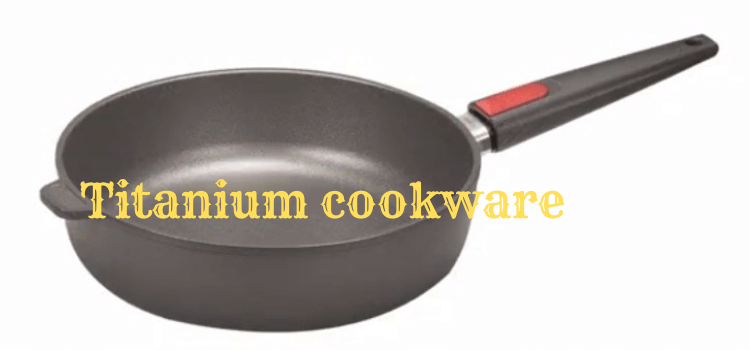
What is Titanium cookware?
Titanium cookware is made chiefly or entirely of the firm and durable metal titanium,well-known for its resistance to corrosion as well as its excellent strength-to-weight ratio. Many people love this kind of cookware because of its many valuable features; one is how easy it is to carry around, which is particularly helpful when camping or hiking. The cookware will last long thanks to titanium’s remarkable resilience, which protects it from dents, scratches, and corrosion.
Titanium cookware stands out due to its inert nature, which means it doesn’t react with food and doesn’t add any metallic flavors or compounds that could be harmful. People who want to stay away from metals that are bad for their health will love it because of this. To improve heat conductivity and cooking performance, some titanium cookware includes other materials in the base, including aluminum.
In addition, titanium cookware can be coated to have nonstick characteristics, which makes cleaning it easier and means less oil or fat is needed when cooking. The material is also great for various cooking techniques because it can endure high temperatures without distorting or losing structural integrity.
Although titanium cookware has many benefits, it might still be more expensive. Coatings and other constructional elements may affect the cookware’s performance and longevity. Follow the manufacturer-provided care and usage recommendations to get the most out of your product and extend its life.
titanium vs aluminum cookware you can review our post.
PROS
CONS
12. Enamel:
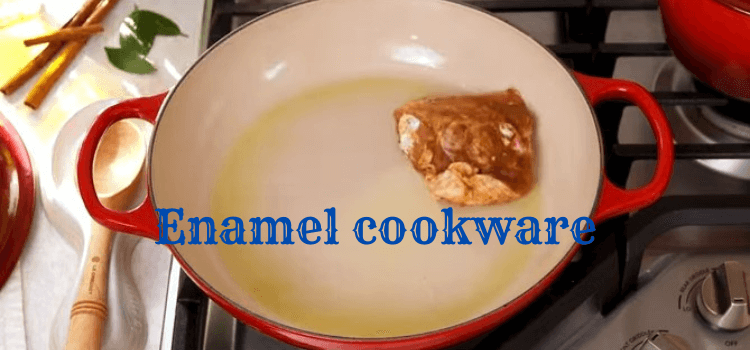
What is Enamel cookware?
Cookware, including pots and pans, that have been coated with enamel, a glass-like substance, is known as enamel cookware. Cast iron or steel, for example, can spray this coating to make it shiny and smooth, with no reactivity and no maintenance required. Versatility is the word of the game for this enamel-coated cookware, which can be used for everything from baking to cooktop cookery. Its varied color possibilities add to its aesthetic appeal, which makes it highly sought-after. You can cook many different things in enamel cookware without tasting metallic because it is long-lasting, doesn’t rust, and can handle a wide range of ingredients.
PROS
CONS
13. Granite:
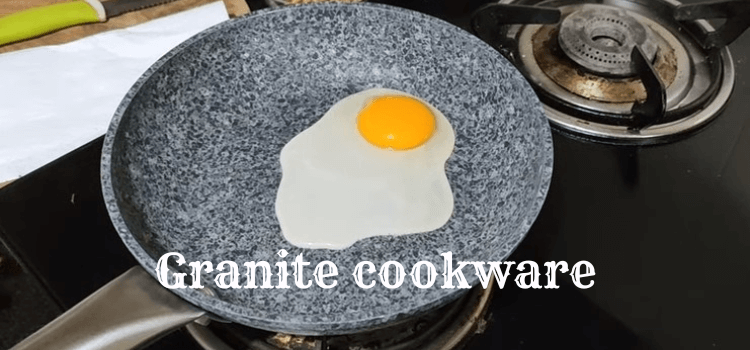
What is Granite cookware?
Cookware made of composite material that includes crushed granite stone is known as granite cookware. This material provides a nonstick coating to the pans, utensils, and other kitchenware in the granite cookware category. Despite the name, most granite cookware uses a covering that is a mixture of crushed granite and other materials rather than solid granite. Various cooking utensils can have their surfaces coated with this unique material, which creates a long-lasting nonstick layer that improves performance.
Granite cookware is known for its nonstick qualities, which make it easy to clean and enable you to cook efficiently with little oil or fat. Coatings that contain crushed granite increase the cookware’s longevity by protecting it from every day wear and tear as well as scratches and abrasions. For more uniform and thorough cooking, look for a granite cookware set that distributes heat evenly across the surface.
Aesthetically pleasing and functional, granite cookware often has a speckled look reminiscent of actual granite stone. In addition to making cooking more aesthetically pleasant, this can also improve the kitchen’s functionality.
Although there are many benefits to using granite cookware, keep in mind that the nonstick coating’s efficiency and durability could differ from one brand and quality of cookware to another. Also, be wary of using metal utensils on the layer; certain sets won’t work with induction stoves because they don’t have any magnetic qualities. In general, granite cookware is a one-of-a-kind and adaptable choice among kitchenware, combining form and function beautifully.
ceramic vs granite cookware you can review our post.
PROS
CONS
14. Bamboo:
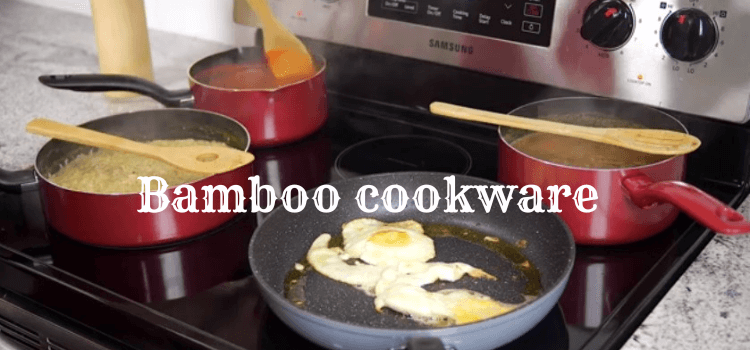
What is Bamboo cookware?
Bamboo is a sustainable and multipurpose material mainly used to make a variety of culinary utensils, containers, and tools. Bamboo is an environmentally friendly option for cookware due to its rapid growth and maturity. The shoots and fibers of the bamboo plant are used to make various cooking and storage items.
One typical use for bamboo in the kitchen is as a cutting board. The natural antibacterial qualities, resilience to knife scars, and long lifespan of these cutting boards have earned them a stellar reputation. For those who want to use nonstick cookware, bamboo spoons, tongs, and spatulas are great options because they are lightweight and friendly on cookware.
One such famous category of bamboo kitchenware is the steamer baskets. By taking advantage of the inherent porosity of bamboo, these time-honored Asian cooking implements steam meals. The delicate, earthy flavor that bamboo steamers can add to food is one of the main reasons they are so popular.
Since bamboo is a renewable resource that doesn’t need pesticides or fertilizers and uses very little water, so bamboo cookware aligns with sustainability ideals. Bamboo’s regenerative qualities and quick growth rate further add to its green reputation.
Although there are many benefits to using bamboo cookware, it’s important to remember that some products may need special attention to ensure they last a long time. For example, to keep certain bamboo items from drying out and breaking, oiling them every so often can be helpful. In addition, as bamboo cookware has a wide range in quality, buyers need to choose products from trustworthy vendors to guarantee long-term use and ethical sourcing. Bamboo cookware is popular among eco-conscious individuals since it combines practicality, sustainability, and cultural tradition.
PROS
CONS
Last word:
I hope this article will help you to choose the right cookware for your kitchen. But before buying a cookware, Please read the company declaration. Best of luck, and enjoy cooking.
Amazon and the Amazon logo are trademarks of Amazon.com, Inc. or its affiliates.
Leave a Reply